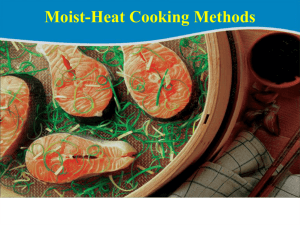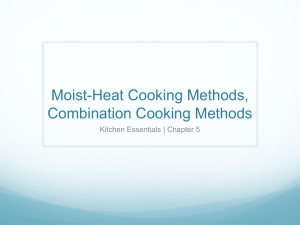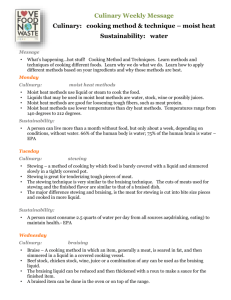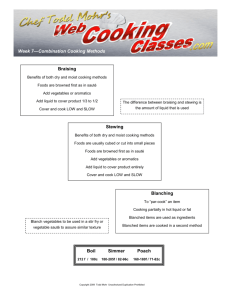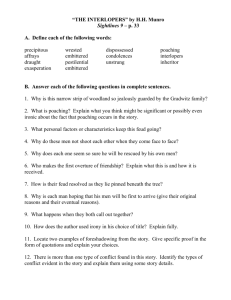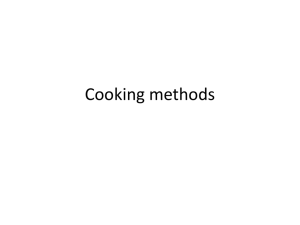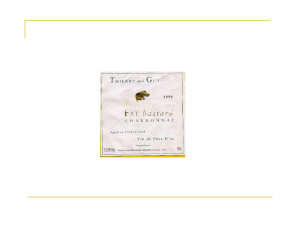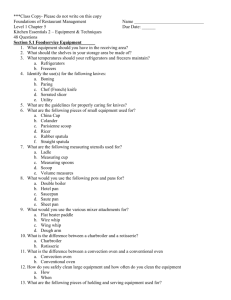Moist Heating Notes Moist heat ppt day
advertisement
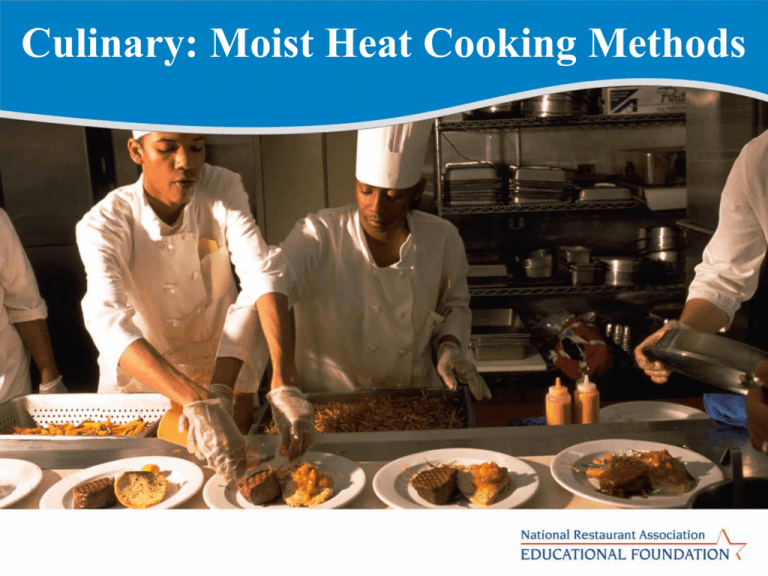
Culinary: Moist Heat Cooking Methods Shallow Poaching Definition: technique where both steam and liquid cook the items • Items are partially submerged in a liquid containing an acidic ingredient • Liquid temperature ranges between 180˚F and 185˚F • A lid should be used to trap the steam • Cooking liquid is used as a base for the sauce that might accompany the items Deep Poaching Definition: technique where items are completely submerged in a liquid • Used for more delicate food items • Note that the liquid should never be allowed to boil, as this causes the item to toughen • Primary difference between shallow and deep techniques is the amount of liquid Poaching Food Selection Items for shallow and deep poaching must be: • Tender cuts of meat • Individually portioned Suitable Food Items for Poaching • • • • • Chicken Variety meat Fish and shellfish Fruit and vegetables Eggs Shallow and Deep Poaching Cooking Liquids • • • • Stock Wine Vinegar Citrus juice Shallow and Deep Poaching Aromatics and Ingredients • • • • • Shallots Vegetables Herbs Spices Citrus zest Shallow and Deep Poaching Optional Components • Butter • Vegetable purées • Tomato concassé Shallow Poaching Procedure • • • • • Heat butter in a sautéuse Sprinkle aromatics in pan and make a level bed Add main item and poaching liquid Bring liquid to a simmer Cover sautéuse with parchment paper Shallow Poaching Procedure—continued • • • • Finish food over direct heat or in an oven Remove main item, moisten, and keep warm Reduce the cuisson and prepare a sauce as desired Serve main item with sauce and appropriate garnish Additional Shallow Poaching Information • Use shallow poaching method for smaller, individually portioned items • Cover poached items once they are removed from the poaching liquid • Items should be started in cold liquid for a clear broth Deep Poaching Procedures • Bring cooking liquid to a simmer • Add main item, using a rack if necessary; be sure item is fully submerged • Finish food over direct heat • Remove main item, moisten, keep warm, or cool in liquid as appropriate • Cut or slice main item and serve with appropriate garnish or sauce Basic Procedure for Deep Poaching • Use deep-poaching method for larger items • Cover poached items once they are removed from the poaching liquid Braising Definition: A method of cooking that involves dry and moist heat • The meat is seared before simmering slowly in liquid with mirepoix and aromatics Braising: Food Selection Items for braising must be: • Less tender, more muscular and mature • Any size (large pieces can be used) Suitable Food Items for Braising • • • • • Beef, veal, lamb, or pork Poultry Game (feathered or furred) Organ meat Vegetables Braising: Cooking Liquid • Liquid – Well-flavored stock – Appropriate jus • Aromatics – Sachet d'épices or bouquet garni Braising Optional Components • Garnishes • Thickener • Tomatoes Braising Equipment • Brazier with tight-fitting lid • Prepared main item (larded, tied, seasoned, or marinated) • Appropriate size pan for the quantity of main item to be braised • Correct amount of liquid Standard Ratio of Ingredients for Braising Main item = 1 lb Mirepoix = 1 oz Liquid = 1 pt Basic Procedure for Braising • • • • • • Season and sear main item on all sides in hot oil Remove main item Add mirepoix and caramelize Add tomato paste and flour, if used Add liquid Return main item to bed of mirepoix in pot Basic Procedure for Braising—continued • Bring to a simmer over direct heat • Cover, finish item in oven until fork-tender • Add sachet d'épices or bouquet garni and garnishes at appropriate times • Remove main item and keep warm Basic Procedure for Braising—continued • To prepare sauce – Strain, reduce, thicken, and garnish as desired • Slice or carve main item and serve with a sauce and appropriate garnish Additional Braising Information • Searing adds flavor and color • Use appropriate size cooking vessel in relation to the quantity of meat • Larding is advisable on cuts with insufficient marbling • Where suitable, marinating contributes to tenderizing and flavor Additional Braising Information—continued • Thicken stock for braised items by: – Deglazing and adding brown sauce – Adding flour to fat and mirepoix, then adding brown stock – Cooking in stock, reducing liquid, and thickening Braising: Things Not to Do • Don’t allow liquid to boil during cooking • Don’t use too much liquid Stewing Definition: Stewing is similar to braising, but the main item is cut into bite-size pieces • Amount of liquid used in relation to the quantity of the item varies from one style of preparation to another Stewing: Food Selection • Items to be stewed must be: – Less tender, more muscular and mature – Small, bite-size pieces Suitable Food Items for Stewing • • • • Beef, veal, lamb, or pork Poultry Game (feathered or furred) Organ meat Stewing: Cooking Liquid • Well flavored stock • Appropriate jus Stewing Optional Components • Tomatoes • Thickener • Garnish Basic Procedure for Stewing • Sear or blanch main item • Remove main item from pot; drain blanching liquid, if used • Brown or sweat mirepoix • Return main item to bed of mirepoix in pot • Add liquid Basic Procedure for Stewing—continued • Bring the item to a simmer over direct heat • Cover pot; finish item in oven • Add sachet d'épices or bouquet garni and garnish at appropriate times • Reduce sauce, if necessary • Garnish item as appropriate and serve Additional Stewing Information • Searing adds flavor and color • Use appropriate size cooking vessel in relation to the quantity of meat • Where suitable, marinating contributes to tenderizing and flavor Stewing: Things Not to Do • Don’t allow liquid to boil during cooking • Don't use too much liquid
